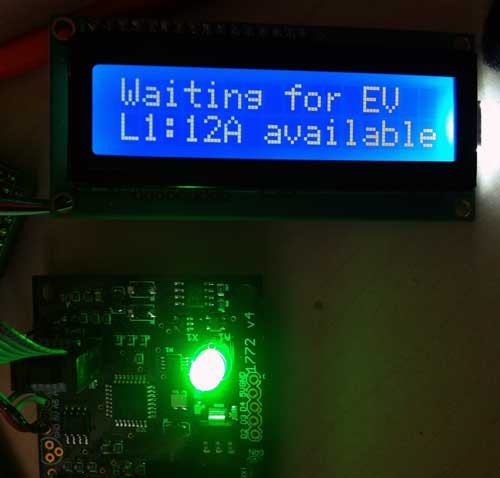Last year, I purchased a Nissan Leaf, which is an all electric vehicle (EV). Although the Leaf comes with an included L1 EVSE (“trickle charger”), which connects to a regular 120V wall outlet, it takes way too long to charge the car. The more practical solution is to purchase and install a J1772 L2 EVSE which is equivalent to the commercial charging stations you see in public parking lots. The problem is the cost. J1772 L2 EVSE’s cost a couple of thousand dollars; the quote I got from Aerovironment, Nissan’s chosen installer was about $4000 including installation. Considering that modern EV’s using the J1772 standard have the charger built-in to the car, and that a J1772 EVSE is no more than a smart safety interlock plug for connecting the car to the wall, I thought the cost was pretty outrageous.
I obtained a copy of the SAE J1772-2010 standard, and after a few hours of perusing it, realized that a J1772 EVSE could be implemented with an Arduino, a few parts, and a relay at the fraction of the cost of the commercial products. Furthermore, that the circuitry is so simple and compact that it could be built into a small case that fits into your hand, and can easily be thrown into your trunk, rather than the giant monstrosities like GE’s WattStation.
I started to design my own EVSE around an AVR MCU, but soon discovered that Chris Howell had had exactly the same idea, and posted about his Weekend EVSE project on the MyNissanLeaf forums. Chris had already made major progress on the project, so I thought, why reinvent the wheel? I contacted Chris, and we decided to team up to develop an inexpensive, portable L1/L2 J1772 EVSE. Chris is a wizard with PCB layout, and has shrunken the board down to smaller than an Arduino over several revisions. It’s truly a sight to behold how tiny and simple it is after seeing the giant messy hackorama that’s being funded by the DOE, the $5000 Blink EVSE, which is just an amalgam of OFF THE SHELF DEVICES IN THEIR ORIGINAL CASES: http://www.mynissanleaf.com/viewtopic.php?f=26&t=5664 . One thing that I find annoying about commercial EVSE’s is that they often waste too much power in standby mode. Nissan’s included EVSE draws about 3W in standby, which doesn’t sound like much, but the question is WHY? Vampire power wastes about 10% of the energy used by a typical residential household. I’ve heard that the Blink wastes more than 50W when it’s doing nothing. Not only that, many of the commercial offerings (including Nissan’s included L1 EVSE) aren’t even 100% J1772 compliant!
After many hours of tweaking and testing, we designed a 100% J1772 compliant dual mode L1/L2 EVSE.
This DIY EVSE has worked flawlessly charging my Leaf ever since last summer:
The actual EVSE logic board is the tiny PCB at the top with the 3 LED’s attached to it. The switching power supply is on the bottom right, and a 30A relay is on the bottom left. A CT in the upper right is used to detect ground faults.
For a portable unit to throw in my trunk, I need adjustable current, so I’ve implemented a 1-button menu interface using a common HD44780-compatible 16×2 LCD, connected to an Adafruit LCD backpack, which greatly reduces the pin count required for interfacing to it. I’m currently using it in i2c mode.
Note how small the controller PCB is now … Chris is a PCB layout ninja … yes, that’s a complete implementation of a J1772 EVSE on that tiny board. Now, go back to the Blink EVSE link I listed above, and see how huge and complex the circuits are in the commercial offerings THAT AREN’T EVEN 100% compliant to the standard!
This time, instead of going into the expensive box I bought for the first EVSE, it’s going to live in a $5 NEMA wiring box from my local hardware store. I think this box will be a lot more durable against getting dropped and thrown around than my fancy $18 NEMA box.
Hardware hackers, what are you waiting for? Join in on the fun. We’ve open sourced the design as OpenEVSE: http://code.google.com/p/open-evse/. Now, you can build your own fully hackable, customizable EVSE!
DISCLAIMER: Don’t jump into this project unless you have a thorough understanding of the precautions which must be taken when dealing with high voltages and currents. It’s quite easy to electrocute yourself and DIE if you don’t know what you’re doing.

